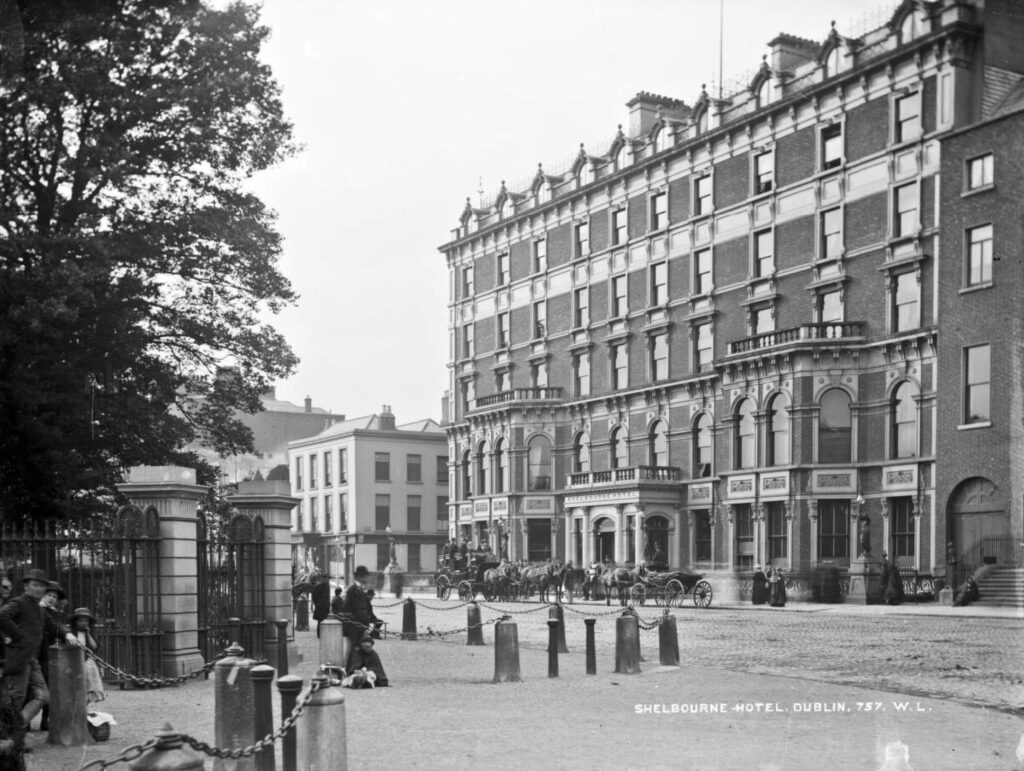
In the heart of Dublin, gazing serenely across St. Stephen’s Green, stands The Shelbourne Hotel. Founded in 1824, it’s not just a grand hotel; it’s a living testament to Irish history, a place where social gatherings, political dramas, and literary encounters have unfolded for nearly two centuries. Stepping inside The Shelbourne is akin to stepping into a time capsule, where echoes of the past mingle with modern elegance.
A Visionary’s Dream Takes Shape
The Shelbourne’s story begins with Martin Burke, a man from Tipperary with a vision. He yearned for a sophisticated hotel that would cater to Dublin’s elite. In 1824, his dream materialized when he acquired three adjoining townhouses overlooking the city’s verdant oasis, St. Stephen’s Green. With a strategic nod to history, Burke named his establishment “The Shelbourne,” a subtle homage to William Petty, the 2nd Earl of Shelbourne, who once owned a house on the same site. The name imbued the hotel with an air of nobility, attracting the city’s upper crust.
Innovation was a hallmark of The Shelbourne from the very beginning. Burke, a man attuned to the latest advancements, embraced gas lighting – a marvel that cast a warm glow on the hotel and set it apart from the competition. Opulent drawing rooms were added, creating a sense of grandeur and fostering a vibrant social scene.
Literary Haunts and A Brush with Revolution
The Shelbourne quickly became a magnet for prominent figures. William Makepeace Thackeray, the literary giant behind “Vanity Fair,” was an early guest in 1842. His stay left a lasting impression, inspiring him to write about The Shelbourne’s allure in his “Irish Sketch Book.” The hotel became a haven for writers, artists, and intellectuals, solidifying its reputation as a cultural hub.
However, history wasn’t just witnessed within the Shelbourne’s walls; occasionally, it spilled onto its doorstep. During the tumultuous Easter Rising of 1916, the hotel became an occupied zone. British troops held the fort against Irish rebels who had taken control of St. Stephen’s Green. The bullet holes that peppered the Shelbourne’s facade during the conflict stand as a stark reminder of this period of national upheaval.
A Stage for Political Drama and An Unexpected Guest
The Shelbourne wasn’t just a venue for social gatherings and artistic pursuits; it also played a pivotal role in shaping Ireland’s political landscape. In the wake of the Irish War of Independence, the nation grappled with its future. In 1922, a series of historic meetings were held in the Shelbourne’s Room 112. Here, under the chairmanship of Michael Collins, the committee responsible for drafting the Constitution of the Irish Free State convened. The words that shaped a new Ireland echoed through the very walls of The Shelbourne. Today, Room 112, aptly renamed “The Constitution Room,” stands as a testament to this pivotal moment in Irish history.
Adding a curious twist to the Shelbourne’s narrative is the brief stint of Alois Hitler, Jr., Adolf Hitler’s elder half-brother, at the hotel in the early 1900s. While details remain scarce, Alois Hitler, Jr. reportedly worked as a kitchen porter during this time. This strange connection adds an unexpected layer to the Shelbourne’s rich tapestry, a reminder that history often throws up surprising encounters.
Enduring Elegance Through Wars and Social Change
The Shelbourne has weathered the storms of history, emerging each time with renewed grandeur. Throughout the 20th century, it continued to attract a glittering clientele. Hollywood stars like John Wayne and Maureen O’Hara graced its halls, while international political figures like Charles de Gaulle and Nelson Mandela chose it as their Dublin residence. The Shelbourne remained a symbol of Irish hospitality, a place where tradition seamlessly blended with modern luxury.
A New Era Dawns: Modernity Meets History
The 21st century ushered in a new era for The Shelbourne. A meticulous restoration project in 2000 ensured the hotel retained its historic charm while embracing contemporary comforts. Today, The Shelbourne offers a unique experience, a harmonious blend of old-world elegance and modern amenities. Afternoon tea in the Lord Mayor’s Lounge transports guests back to a bygone era, while the vibrant bars and restaurants cater to the discerning modern traveler.
The Shelbourne’s story is far more than just bricks and mortar. It’s a chronicle of Dublin’s social and political evolution. From its early days as a fashionable haunt to its role as a stage for momentous political change.
